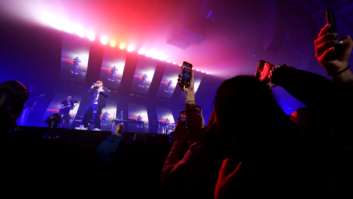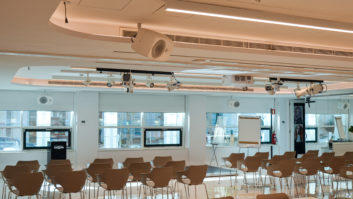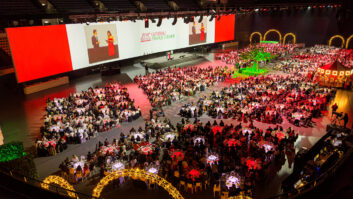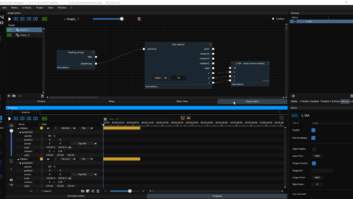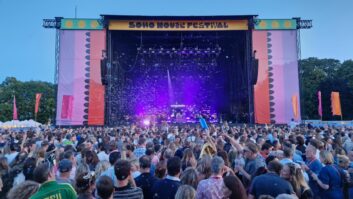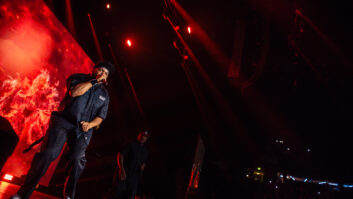A range of regional and international touring artists feature at the four-day outdoor festival, which has showcased an eclectic mix of live music and art, alongside wellness and lifestyle activities, since 2014. This year, the fields of the Siam Country Club once again offered performances across world music, jazz and Thai funk during the day, and morphed into electronic beats after sunset.
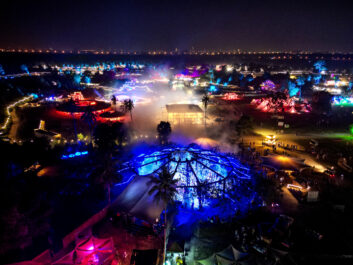 Among the dozen stages on the 140-acre festival site, Polygon stands out for its originality. A 2,000-plus-capacity arena, Polygon comprises a 25-metre diameter honeycomb-shaped dome. This hemispherical structure is rigged with 360° L-ISA Immersive Hyperreal Sound technology from L-Acoustics, as well as cutting-edge lighting and visual effects. The dome, which debuted at Wonderfruit in 2018, is designed to be multisensory, and even gently disperses scents to enhance festivalgoers’ experience.
Among the dozen stages on the 140-acre festival site, Polygon stands out for its originality. A 2,000-plus-capacity arena, Polygon comprises a 25-metre diameter honeycomb-shaped dome. This hemispherical structure is rigged with 360° L-ISA Immersive Hyperreal Sound technology from L-Acoustics, as well as cutting-edge lighting and visual effects. The dome, which debuted at Wonderfruit in 2018, is designed to be multisensory, and even gently disperses scents to enhance festivalgoers’ experience.
Last year, the Polygon stage hosted live sets from electronic music artists such as Viken Arman, Photay, Âme and O/Y, who pushed the tempo late into the night.
Live sets afford electronic music artists the opportunity to create new interpretations and arrangements of their well-known pieces. When the Polygon team informed the artists that they would have the chance to perform in 360° immersive audio, they began working together to prepare their sets for this new technology. With the artists spread around the world, these sessions were conducted both in person and remotely.
French DJ-producer Viken Arman was able to put L-ISA to the test in a London studio before the festival began. Known for his minimal style of electronic music, Arman spent a whole day listening to his tracks on an L-ISA system and was immediately blown away by it. “I left the London L-ISA studio having a sense that this wasn’t just an immersive gadget attached to a few surround speakers,” he said. “I could see many possibilities beyond a standard stereo output mix. It got me to think critically about the spatialisation of every sound in my tracks for the Wonderfruit set.”
Ahead of his performance, Arman also tested his live mix at the Polygon stage on-site at Wonderfruit. There, Polygon’s spatial engineers, led by Davey Williamson and including Matt Gush and Matt Hill, helped him to move his percussive and modular synthesiser elements around the L-ISA system.
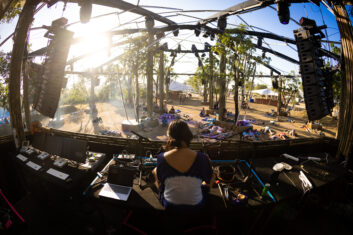 American musician Photay (Evan Shortstein) depended on a more extended soundcheck slot at the festival. After a virtual consultation with Gush, he prepared most of his performance material in a home studio and on the plane to Thailand. During his soundcheck time, Photay solidified his vision of how he would organise his stems into channels with clear categories, allowing for smooth transient textures, rhythmic beats, melodies, percussion and drums.
American musician Photay (Evan Shortstein) depended on a more extended soundcheck slot at the festival. After a virtual consultation with Gush, he prepared most of his performance material in a home studio and on the plane to Thailand. During his soundcheck time, Photay solidified his vision of how he would organise his stems into channels with clear categories, allowing for smooth transient textures, rhythmic beats, melodies, percussion and drums.
“I approached the immersive performance with a minimalistic approach,” Photay explained. “It allowed me to give each sound and its groups the freedom to travel and explore various depths and heights within the L-ISA system.”
Like the other artists, Berlin-based musician O/Y, had used an eight-point surround system before, utilising an audio interface to route eight channels to an ambisonic system. To prepare his show, he was introduced to L-ISA technology during a studio session where he began to experiment with using all 64 output channels. After that session, O/Y reorganised all his tracks’ stems and re-approached the live mix, opting for a clean and concise overall mix on each of the 64 output channels without the need for bus mixes, input returns channels or master chain processing.
The Earth Echo collective, led by sound artist Phan Tu, had a different approach to preparing its daytime sound healing sessions. Earth Echo’s sound bath content involves Tu using both a soundscape playback and live instruments, which she moves over the bodies of participants so that they can physically feel the sound around them.
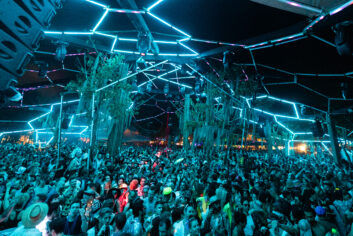 Earth Echo’s dedicated spatial audio engineer, Daniel Figols, shared his tracks with Gush, who then optimised the mix in the Delta Live L-ISA studio. “After Figols prepared our mix, we tested our content on a similar Polygon rig at MDLBEAST’s Soundstorm festival in Riyadh, Saudi Arabia, a few weeks prior,” said Tu. “It was fundamental to understanding how our tracks reached ears and bodies within the live space and allowed us to adjust our sounds and stems for a more optimal experience at Wonderfruit.”
Earth Echo’s dedicated spatial audio engineer, Daniel Figols, shared his tracks with Gush, who then optimised the mix in the Delta Live L-ISA studio. “After Figols prepared our mix, we tested our content on a similar Polygon rig at MDLBEAST’s Soundstorm festival in Riyadh, Saudi Arabia, a few weeks prior,” said Tu. “It was fundamental to understanding how our tracks reached ears and bodies within the live space and allowed us to adjust our sounds and stems for a more optimal experience at Wonderfruit.”
Using L-ISA immersive audio, the Earth Echo program can deliver a more powerful auditory experience to ten times more participants per session, as there was no need to play the instruments in the space physically since the immersive configuration translated the physical sound bath experience perfectly.
For Photay, Viken Arman and O/Y, the Wonderfruit performances with L-ISA technology were a first. The comprehensive immersive audio system changed how they performed their unique brand of electronic music, and they felt more creative as they played and improvised. The musical dialogue with the audience was also an entirely new experience and proved to be a hit with the festival’s audiences.
“The crowd during my set seemed more interested in listening than just dancing,” concluded O/Y. “I believe L-ISA technology played a major role in evoking this unique response. It is a game changer for the festival experience produced by Polygon, powered by L-ISA.”
